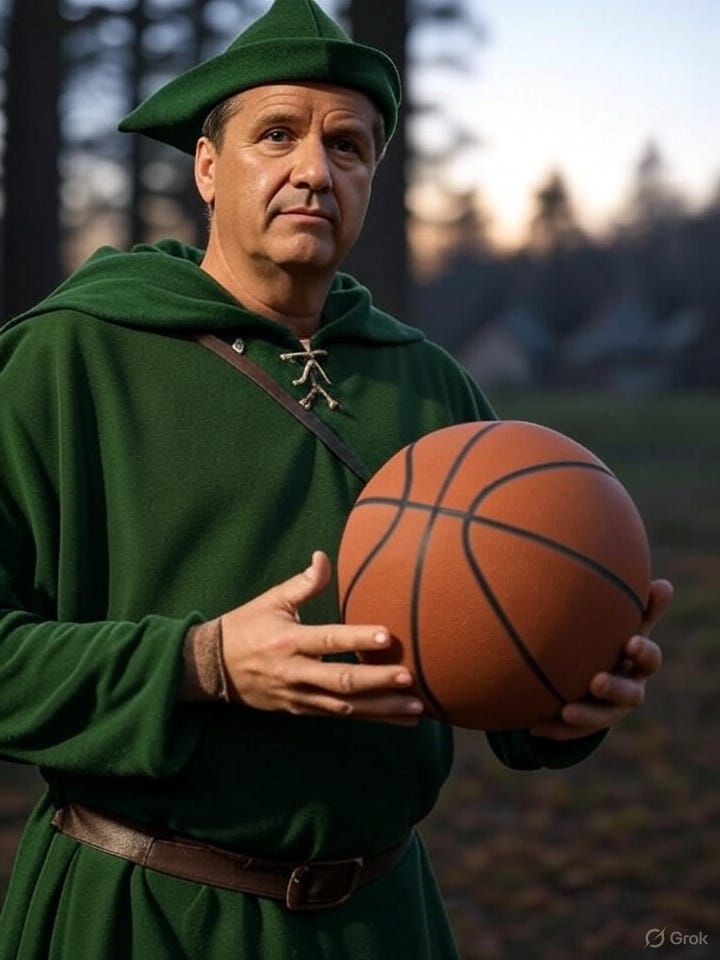John Calipari should become basketball Robin Hood
Offseason Razorback Reels explores basketball concepts to steal from the rich and give to the poor.
The idea that “Good artists copy, great artists steal” is most commonly attributed to Pablo Picasso. Let me tell you this, Pabs, I think you were onto something, my guy–something that I hope Arkansas Razorbacks head basketball coach John Calipari takes to heart.
For Arkansas to take the next step, Calipari must become a basketball Robin Hood. He needs to steal successful concepts from the rest of the coaching profession at all levels and give those bounties to his squad.
Luckily for Calipari, I’ve done some of that legwork for him. Consider me the Friar Tuck of the Razorback Merry Men.
What I’ve compiled here today are all actions and sets I’ve stolen from other SEC basketball teams who advanced further than the Razorbacks in the NCAA Tournament. All these plays were used in either the SEC or NCAA Tournament. More specifically, these are all plays designed to help the Razorbacks become richer in a poor area for them last year: big man interior scoring.
I should note that I’m higher than most people on what I think Malique Ewin’s offensive impact will be. His skill set alone should improve this area. Still, Calipari can let his chalk carry some weight as well. How could he do that?
Let’s roll the tape!
Do you know how they say “Robin Hood” in Spain?
Turns out they just say Robin Hood.
I ask because the first set I would steal if I were Calipari is Spain PnR. At its core, the Spain PnR uses the following sequence:
A big sets a screen for a ballhandler who is usually at the top or on the wing.
The big rolls to the rim.
As the big rolls to the rim, a third player sets a backscreen on the big’s defender. When executed properly, this creates confusion and can lead to easy buckets at the rim. Additionally, that second screener can also pop to the three-point line after screening and create another scoring threat.
Let’s start with this example from Tennessee, since we all know Calipari has a deep fondness and respect for Rick Barnes. Seems like a good dude to rob, if you ask me!
The first thing to notice here is that Tennessee has the other two players more or less staying stationary in their Spain set on the weakside of the ball. This is absolutely one way to ensure you are playing three-on-three basketball in this set and not three-on-four/five with help defenders.
The rest of the clip is a fundamental example of the abovementioned steps. The Tennessee point starts on the right wing, and the Volunteer big man comes up from that same elbow to set a ball screen. Wofford is in drop defense (the most susceptible coverage to the benefits of Spain), so as soon as the Tennessee big makes contact with the Wofford defender, he rolls hard to the rim. His man turns to chase after the roll, and he is immediately hit in the back by another Volunteer screener. Wofford does not cover this screen well, and the Tennessee point lobs it up for a dunk. The Wofford help that does arrive at the rim is an afterthought at that point.
Here’s an example of one way Auburn used Spain to get easy buckets for their big that looks a little different from how Tennessee got into their version:
This is a cool way to get into Spain and a nice wrinkle that keeps the other defenders occupied. The play begins with a 21 action, where the ballhandler and a guard on the wing run a dribble handoff on the left side. That initial ballhandler then curls all the way to the opposite elbow to set the backscreen for the Tiger big man. Meanwhile, Auburn swings the ball A to B to C, and their big sets the initial screen of their Spain set and rolls to the rim.
Here’s what makes this an interesting variation of Spain. After the Auburn big sets a screen, the Spain ball handler dribbles back toward the top of the key because Auburn is simultaneously running a flare screen on the weakside. The ballhandler now has some choice about where to go. He can take a shot himself, hit the open shooter off the flare screen, or dish to the rolling big. It pains me to say it, but that is fantastic design and execution by Bruce Pearl and the Tigers.
These two clips just scratch the surface of what Arkansas could do with Ewin in Spain sets. There are about 1,000 more variations we don’t have time to get into right now. The point is that Spain could help bring some scoring efficiency in the post for the Razorbacks.
Robin Hood Flexed for justice
If Spain is a clear set that would help Arkansas’s interior scoring presence, I want to talk about a few actions that could also help. The first one we’ll discuss today is a flex cut.
A flex cut is an off-ball cut that typically occurs along the baseline, and generally goes as follows:
A player in the weakside wing or corner cuts across the court to the strongside block.
A player uses a screen set by a teammate on the block or in the paint to get open near the rim.
When used effectively, a flex cut is going to create high-percentage looks at the rim or in the paint, and it is going to force the defense to be connected off the ball, which is ideal for forcing breakdowns by the offense. Typically, that cutting player is a guard or a wing, and it is the big setting the screen down low. However, there ain’t no rule that says a dog can’t play basketball. And there’s nothing that says the big can’t be the player cutting to get open near the rim. For an video example, we go back to the Auburn Tigers.
When you look at clips of Ewin at Florida State last year (linked above is a previous Razorback Reels that has some preselected for you), it’s not hard to envision him being successful in this exact action. He likes to initiate from the perimeter as opposed to being a traditional low-block, back-to-the-basket big.
Robin Hood and his pet ram
The Ram Screen is another action Arkansas should look to add to its offensive toolkit next year. A Ram Screen follows this sequence:
A teammate sets an off-ball screen for a big.
That big man then sets a ball screen.
In some ways, a Ram screen feels like Spain in reverse. There are tons of benefits to using a Ram screen. It allows the big to go into the ball screen with space already created, making it much harder to defend. It also disguises the pick and roll. The defense can get caught up in defending the off-ball action, not knowing that the ball screen is the real danger. Most importantly, it is a great action to throw at a switch-heavy team. If the defense switches on the initial off-ball screen, you could create a mismatch before the ball screen even happens.
For examples of this, let’s watch some film from one of the top five offenses in all of college basketball last season, the Alabama Crimson Tide:
In example one, we see Alabama run a prototypical Ram screen. A guard runs a pindown for the big, who then sets the ball screen and rolls to the basket. BYU does not switch on the off-ball screen but does switch the ball screen, which leads to Alabama’s big rolling for a lob attempt against a much smaller trailing defender. BYU is forced to send a help defender, whose only choice is to foul.
In example two, we see another benefit of a Ram screen: it can flow easily into other actions. In this clip, we see the initial off-ball screen, but the Crimson Tide ghosts the on-ball screen. The initial off-ball screener follows and sticks to his screen. It’s that initial off-ball screener who ends up rolling and finishing the lob attempt with a high-percentage look.
This action could do wonders for Ewin (and any ballhandler lucky enough to pick up easy assists passing to him), but it could also be a great wrinkle for Nick Pringle.
Key Takeaways
There are two key takeaways from all these concepts. The first is that all of them have variations and tweaks that will keep the defense guessing. Calipari is a coach who likes to empower his players to make decisions when they are on the floor. Adding these wrinkles to the playbook can allow Calipari to have his cake and eat it, too. He can build in schemes that will lead to better choices for the players on the floor.
Second, Ewin can drastically improve Arkansas’s interior scoring prowess, but it won’t happen without some conscious choices in the game plan. Calipari is a Hall-of-Famer who I trust implicitly to run a basketball team successfully. In the same breath, it wouldn’t hurt Calipari to steal from conference foes to give to his roster. He didn’t have an offensive impact big like Ewin on campus last season, so borrowing from other playbooks could help jumpstart Ewin’s integration into the scheme.
Robin Hood green looks good on him. Anything is better than Kentucky blue.




